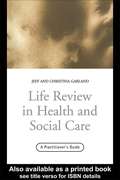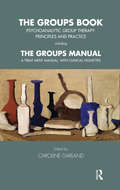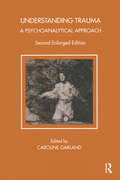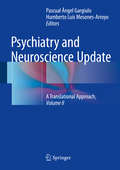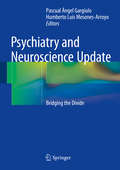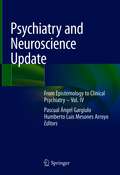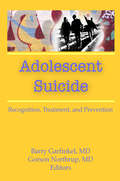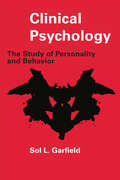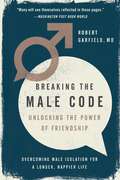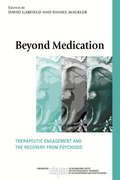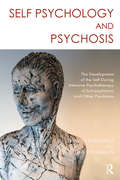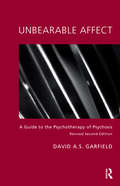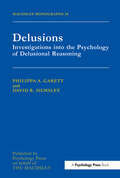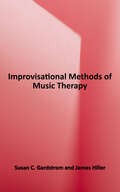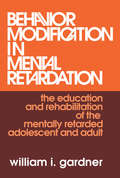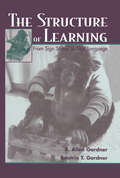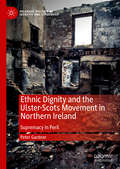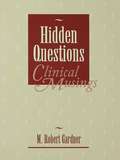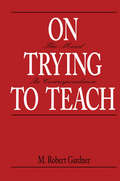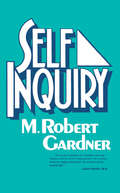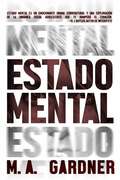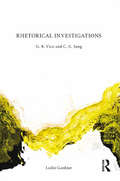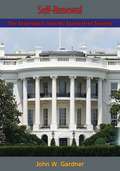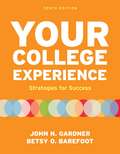- Table View
- List View
Life Review In Health and Social Care: A Practitioners Guide
by Jeff Garland Christina GarlandHow can understanding our past help us face the future? The key to gaining awareness of the present and preparing for the future lies in our understanding of the past, yet there is little coverage of this topic in the existing psychology and counselling literature. How can people improve themselves by greater self-knowledge? Jeff and Christina Garland break new ground in making a straightforward presentation of the theory and practice of the everyday process of life review, which is atherapeutic approach for helping clients make sense of their past, and can be used to help change undesirable behaviour and plan for the future. The theory and structure of the life review process are examined, and clinical examples of how it works in practice are given; this includes interviews both with "narrators" (people engaged in life review) and "listeners" (health and social care professionals). These examples demonstrate how professionals can use life review to help their clients overcome difficulties in their lives and face the future with confidence. Life Review will appeal to trainees and practitioners in occupational, developmental, clinical and health psychology, social work, counselling, psychotherapy and nursing.
The Groups Book: Psychoanalytic Group Therapy: Principles and Practice (Tavistock Clinic Series)
by Caroline GarlandThis book examines the ways in which we make use of the Group Relations model, set up in the experimental field of the Group Relations conferences, to understand and modify the functioning of working groups. It is based on a psychoanalytic knowledge of the psychosocial development of human beings.
Understanding Trauma: A Psychoanalytical Approach (Tavistock Clinic Series)
by Caroline GarlandRevised edition with additional chapter. This book, from the Tavistock Clinic Series, is about what follows the breakdown in functioning, either short or longer-term, provoked by a traumatic event. The authors offer a psychoanalytical understanding of the meaning of the trauma for an individual, illuminating theory with detailed clinical illustration and case histories. A range of therapeutic procedures is described.Major disasters draw attention forcibly to their effects on the survivors. Less often recognised are the long-term after-effects of the huge number and variety of more private events, either accidental or deliberately inflicted, on an individual's subsequent emotional and working life. This book is about what follows the breakdown in functioning, either short or longer-term, provoked by a traumatic event.What is distinctive about this book is that its authors offer a psychoanalytical understanding of the meaning of the trauma for an individual, illuminating theory with detailed clinical illustration and case histories. They show the process of treatment as their patients restore meaning to their lives, moving towards a new integration in which the event becomes a part of the whole, no longer dominating either waking or sleeping life. A range of therapeutic procedures is described, including a short series of individual consultations, groups and full analysis. A challenging and innovative work, rooted in psychoanalysis, this collection thoughtfully describes in detail the work for the Unit for the Study of Trauma and its Aftermath in the Adult Department of the Tavistock Clinic.
Psychiatry and Neuroscience Update - Vol. II
by Pascual Ángel Gargiulo Humberto Luis Mesones-ArroyoThe aim of this unique book is to provide an overview of recent advances bridging the gap between psychiatry and neuroscience, allowing a fruitful dialogue between both sciences. The emerging interactions and mutual contributions between neuroscience and psychiatry are here recognized. This book is designed to identify the borders, trends and implications in both fields today. Comprehensive and developed by a renowned group of experts from both fields, the book is divided into four parts: Epistemological Considerations About the Study of Normal and Abnormal Human Behaviors; From Basic Neurosciences to Human Brain; Neurosciences, Learning, Teaching and the Role of Social Environment; and Explaining Human Pathological Behaviors: From Brain Disorders to Psychopathology. A unique and invaluable addition to the literature in psychiatry and neuroscience, Psychiatry and Neuroscience Update - Vol. II: A Translational Approach offers an important and clearer understanding of the relationship between these two disciplines. This book is directed to students, professionals and researchers of medicine, psychology, psychopedagogy and nursery.
Psychiatry and Neuroscience Update
by Pascual Ángel Gargiulo Humberto Luis Mesones ArroyoThe intention of this unique title is to bridge the gap between psychiatry and neuroscience, allowing a fruitful dialogue between both sciences. Recognizing that psychiatry has received important contributions from the basic neurosciences and that the basic neurosciences have received inspiration and objectives from the open problems of psychiatry, Psychiatry and Neuroscience: Bridging the Divide is designed to identify the borders, trends and implications in both fields today. Comprehensive and developed by a renowned group of experts from both fields, the book is divided into four parts: Epistemological Considerations About the Study of Normal and Abnormal Human Behaviors; From Basic Neurosciences to Human Brain; Neurosciences, Learning, Teaching and the Role of Social Environment and Explaining Human Pathological Behaviors: From Brain Disorders to Psychopathology. A unique and invaluable addition to the literature in psychiatry and neuroscience, Psychiatry and Neuroscience: Bridging the Divide offers an important and clearer understanding of the relationship between psychiatry and neuroscience.
Psychiatry and Neuroscience Update: From Epistemology to Clinical Psychiatry – Vol. IV
by Pascual Ángel Gargiulo Humberto Luis Mesones ArroyoThis broad and thought-provoking volume provides an overview of recent intellectual and scientific advances that intersect psychiatry and neuroscience, offering a wide range of penetrating insights in both disciplines. The fourth volume on the topic in the last several years from a varying panel of international experts identifies the borders, trends and implications in both fields today and goes beyond that into related disciplines to seek out connections and influences. Similar to its three Update book predecessors, Psychiatry and Neuroscience – Volume IV presents a range of interesting topics in the main disciplines – psychiatry and neuroscience – and attempts to provide deeper comprehension or explication of the normal and diseased human mind, its biological correlates and its biographical and existential implications. This engaging volume continues the previous style of exploring different disciplines and trying to integrate disciplinary evidence from varying points of view in an organic manner. The first section is about epistemological considerations regarding the study of normal and abnormal human behaviors, including, for example, the topic of phenomenological psychopathology and phenomenological psychiatry in relation to schizophrenia and substance misuse, among other topics. Section 2 addresses issues around the translation of basic neuroscience to expression in the human brain and behavioral implications. Section 3 discusses the issues of learning, teaching and the role of social environment in the field of neuroscience. Finally section 4 reviews various perspectives on explaining human pathological behaviors -- from brain disorders to psychopathology.
Environmental Noise Control: The Indian Perspective in an International Context
by Naveen GargThis book provides a concise and up-to-date overview of environmental noise control issues, utilizing specific case studies from India to help explore noise mapping and monitoring, impact analysis, and policy, among other relevant topics. The book provides an extensive review of recent studies, including references, and describes the latest noise monitoring structures. It also addresses heretofore under-emphasized topics, including but not limited to acoustic metrology, Multi Attribute Decision Making (MADM) techniques, and sound insulation utilizing passive control strategies.
Adolescent Suicide: Recognition, Treatment, and Prevention
by Barry GarfinkelInform yourself with thorough and accurate knowledge about the incidence of adolescent suicide. Adolescent Suicide serves to correct erroneous conceptions--held by the public and professionals--about the nature of suicidal behavior among the young, thereby promoting the opportunity for more prompt and effective evaluation and management of potentially fatal incidents. In this landmark volume, authorities address the problem of suicide among adolescents, which has emerged in recent years as a significant public health problem. In-depth discussions of the epidemiology and behavioral characteristics of youth who attempt and complete suicide, risk factors, methods of death, circumstances of the suicidal act, and reasons for the dramatic increase in the phenomenon provide social workers, educators, psychologists, and psychiatrists with systematic information that can be used in both prevention and intervention efforts. There is also a wealth of valuable material here on school-based suicide prevention programs, strategies for managing and counseling the relatives, peers, and classmates of individuals who have committed suicide, and coping with suicide in residential treatment centers.
Clinical Psychology: The Study of Personality and Behavior
by Sol L. GarfieldInterest in clinical psychology has been growing as indicated by large numbers of undergraduates applying for admission to graduate programs and the professional degrees granted. This book is written for anyone with a strong interest in clinical psychology, but also provides a comprehensive and realistic view of the field.The book, therefore, can serve as a reference for courses in clinical psychology, but it will be relevant to courses in personality and personal counseling. Professional clinical psychologists and members of related professions may also find the book valuable because Garfield describes important historical developments that have helped to shape the field, the roles and functions of the clinical psychologist, their training programs, and contemporary issues and problems. The text also describes the theoretical models that guide the work of the clinical psychologist and upon which the divergent approaches to clinical work are based. Changes in the functions of the clinical psychologist are reflected in the greater emphasis on psychotherapeutic and behavior change methods and in the correspondingly reduced emphasis on diagnostic testing procedures--a development discernible in the decline in studies of high quality bearing on diagnostic issues.This book provides a reliable source of information for the individual who contemplates a professional career as a clinical psychologist and seeks to learn what the profession encompasses.
Breaking the Male Code
by Robert GarfieldCalling for a new men's movement, a noted psychotherapist examines the critical role close male friendships play in helping men lead happy, healthy lives.For much of the past century, men have operated under the rules of Male Code, a rigid set of guidelines that equate masculinity with stoicism, silence, and strength. As men's roles have changed over the past few decades, this lingering pressure to hide their emotions has wreaked havoc on men's lives. Lacking the ability to communicate their needs, desires, and feelings effectively, they are more likely to suffer from depression, anger, and isolation, and their relationships often suffer. Noted psychotherapist Rob Garfield has worked with men struggling with emotional issues for more than forty years. Through his "Friendship Labs," clinical settings in which men engage in group therapy, he teaches men how to identify inner conflicts, express emotions, and communicate openly. According to Garfield, traditional therapy has largely marginalized men since many lack the tools to properly engage. But when men learn to open up to other men who share similar experiences, backgrounds, and perspectives, they not only build lasting bonds but learn the skills necessary to thrive in all aspects of their lives. Writing with empathy and authority, Garfield examines the unique challenges men face and urges them to abandon male code in favor of a masculinity that integrates traditional male traits with emotional intimacy skills. He urges men to connect with other men using the Four C's of intimacy--connection, communication, commitment, and co-operation--to form meaningful bonds. Drawing on real-life stories and original research, he shows how their friendships can serve as the foundation on which men can build and sustain deep relationships with all of their loved ones--including spouses, children, and parents--and in turn lead to happier, healthier lives.From the Hardcover edition.ication, commitment, and co-operation.
Beyond Medication: Therapeutic Engagement and the Recovery from Psychosis (The International Society for Psychological and Social Approaches to Psychosis Book Series)
by David Garfield Daniel MacklerBeyond Medication focuses on the creation and evolution of the therapeutic relationship as the agent of change in the recovery from psychosis. Organized from the clinician’s point of view, this practical guidebook moves directly into the heart of the therapeutic process with a sequence of chapters that outline the progressive steps of engagement necessary to recovery. Both the editors and contributors challenge the established medical model by placing the therapeutic relationship at the centre of the treatment process, thus supplanting medication as the single most important element in recovery. Divided into three parts, topics of focus include: Strengthening the patient The mechanism of therapeutic change Sustaining the therapeutic approach. This book will be essential reading for all mental health professionals working with psychosis including psychoanalysts, psychiatrists, psychologists and social workers.
Self Psychology and Psychosis: The Development of the Self During Intensive Psychotherapy of Schizophrenia and other Psychoses
by David GarfieldIn this groundbreaking volume, the authors bring us into the immediacy of the analyst's consulting room in direct confrontation with the thought disorder, delusions and hallucinations of their patients grappling with psychosis. From the early days of psychoanalysis when Freud explicated the famous Schreber case, analysts of all persuasions have brought a variety of theories to bear on the problem of schizophrenia and the other psychoses. Here, as William Butler Yeats notes, "the centre cannot hold" and any sense of self-esteem - positive feelings about oneself, a continuous sense of self in time and a functional coherence and cohesion of self - is shattered or stands in imminent danger. What makes psychoanalytic self psychology so compelling as a framework for understanding psychosis is how it links together the early recognition of narcissistic impairment in these disorders to the "experience-near" focus which is the hallmark of self psychology.
Unbearable Affect: A Guide to the Psychotherapy of Psychosis (General And Clinical Psychiatry Ser.)
by David GarfieldIn this cohesive, dramatic, and highly readable book, the author establishes a roadmap for the diagnosis and psychotherapeutic treatment of psychotic disorders based on finding, understanding and reordering of unbearable affect. He provides concrete clinical advice, vivid examples, and crisp jargon-free descriptions of theoretical concepts and clinical techniques. Most of all, he demonstrates that it is possible for psychotic patients to take control of their conditions, rebuild family relationships, and establish themselves in the viable productive lives that they have long despaired of achieving.
Delusions: Investigations Into The Psychology Of Delusional Reasoning (Maudsley Series #No. 36)
by Philippa A. Garety David R. HemsleyThe authors offer cogent reviews of the literature pertaining to the formation and maintenance of delusions, but the most substantial parts of the monograph expound the empirical inquiries which they and their colleagues have carried out in recent years. Most of the research has been published elsewhere, but such is the relevance of the experiments cited to the whole schema that the monograph has unique value. It is a synthesis which portrays the contribution to date of cognitive science to the biology and psychopathology of delusional thinking, and convincingly demonstrates that this way of looking at things has a considerable future. There are important implications for therapy as well as for hypothesis formulation. The monograph is attractively written, and the authors present their claims with exemplary modesty. The whole tenor of their approach gives weight to the conviction that here we have a story that must be taken seriously. It is a significant book, and I warmly commend it to all those with an interest in the future of psychopathology, and especially to psychiatrists who wish to advance their understanding of mental states and avoid stagnating with outworn dogma." - Robert Cawley, University of London in British Journal of Psychiatry Delusions are a key symptom of psychosis and yet there is no single book which considers delusions from a psychological perspective. In part this is because the syndrome of schizophrenia has captured the attention of many workers, and in part because delusions, as private mental phenomena, are not well suited to purely behavioural or observational methods of enquiry. For the past two decades, however, cognitive psychology has been in its ascendancy and delusions, as beliefs, are particularly amenable to investigation applying cognitive concepts and methods. Within this framework, it is possible to consider continuities between delusional and ordinary beliefs, as well as to seek to identify differences. This book, therefore, uniquely presents a psychological model of delusions, employing the neglected strategy of single symptom research and the tools of cognitive psychology
Improvisational Methods of Music Therapy
by Susan C. Gardstrom James HillerImprovisational Methods of Music Therapy is the second in a series of textbooks addressing each of the four music therapy methods employed in a variety of clinical contexts. Students and professionals alike will gain foundational knowledge about Clinical Music Improvisation (CMI) and its many variations as pertinent to individual, dyadic, and group improvisation. <p><p> This book is specifically intended as a general roadmap for the design and implementation of therapeutically relevant, effective, and individualized improvisation experiences applicable to a wide range of clinical profiles and interpersonal and cultural contexts. As such, Improvisational Methods of Music Therapy addresses prerequisites, risks, contraindications, inherent affordances, and challenges related to CMI, with overarching considerations and procedural steps for Instrumental, Vocal, and Body Improvisation. Attention is given to the use of CMI toward both client achievement of predetermined and measurable therapeutic objectives (i.e., outcome-oriented practice) and client identification and exploration of needs as they manifest in the musicing process (i.e., experience-oriented practice). Hypothetical case illustrations and summaries of actual clinical cases highlight particular CMI variations and procedures.
Behavior Modification in Mental Retardation: The Education and Rehabilitation of the Mentally Retarded Adolescent and Adult
by William GardnerIn this important book, one of the most exciting and promising developments in clinical psychology-behavior modification is applied to the treatment of the mentally retarded, particularly those whose behavior poses difficult problems for institutions. Professor Gardner presents an easily intelligible yet detailed account of the concepts and practices of behavior modification and the underlying learning systems, with numerous clinical illustrations of applying specific techniques to various educational and rehabilitation problems. A thorough discussion of the inadequacies of the psychological evaluation systems normally used in education and rehabilitation is offered, along with an alternative behavior analysis approach that provides a method of translating evaluation data into treatment practices. In explaining behavior analysis, the author takes into account the limited behavioral repertoire of the retarded and environmental deficits. Individual chapters on respondent, operant, and observational learning, and a detailed discussion of a functional analysis approach to evaluation, are included. Proven behavior modification strategies are presented along with a review of related research and clinical studies. The book closes with a detailed description of a research program for the design and testing of sheltered workshop systems for the retarded and emotionally disturbed. The positive approach inherent in the belief that behavior is modifiable-even in the severely limited retarded-is in marked contrast to the pessimism of other systems of therapy, education, and training. Also, the author has concentrated throughout on making the book understandable to clinicians and students with no previous knowledge of behavior modification. Besides serving as a valuable handbook for all treatment personnel, the book can also be used as a basic text for various courses dealing with mental retardation.
The Structure of Learning: From Sign Stimuli To Sign Language
by R. Allen Gardner Beatrix GardnerDrawing together research and theory in ethology and psychology, this book offers a clear and provocative account of the ways in which living organisms learn. Throughout, the authors' focus is on the importance of operational definition. In lively prose, describing experiments in enough depth to involve readers in the drama of experimental method, they recount the history of scientists' attempts to answer basic questions, and show how one study builds on another. Although they present the major traditional positions, they demand that readers examine actual evidence, recognize weaknesses, and consider alternatives. This critical process leads to the delineation of a bottom up, feed forward model in contrast to the traditional top down, feed backward one. Recent research in robotics and fuzzy logic suggests ways in which artificial as well as living systems pursue bottom up, feed forward ethological solutions to practical problems. The authors' extended discussion of their exciting work teaching sign language to chimpanzees vividly illustrates the application of the basic principles of learning elucidated in the book.
Ethnic Dignity and the Ulster-Scots Movement in Northern Ireland: Supremacy in Peril (Palgrave Politics of Identity and Citizenship Series)
by Peter GardnerIn this book, Peter Gardner contends that the production of narratives of ethnic peoplehood is an attempt to regain a sense of collective dignity among the previously dominant. After introducing the concept of ethnic dignity and locating its place within postconflict identity politics, Gardner focuses his analysis on the Ulster- Scots story of peoplehood. Drawing on a wealth of primary data, the chapters explore a variety of core issues including ethnopolitics, social class, political-economic ideology, colonialism, and heteromasculinity. The book concludes by taking a global view of post-conflict ethnic dignity among the once dominant, analysing the New Afrikaans movement in South Africa, white pride and ethnic whiteness studies, and Maronite Phoenicianism in Lebanon. This will be an important contribution for students and scholars of ethnicity, divided societies and, more broadly, political sociology.
Hidden Questions, Clinical Musings
by M. Robert GardnerIn Hidden Questions, Clinical Musings, M. Robert Gardner chronicles an odyssey of self-discovery that has taken him beneath and beyond the categoies and conventions of traditional psychoanalysis. His essays offer a vision of psychoanalytic inquiry that blends art and science, a vision in which the subtly intertwining not-quite-conscious questions of analysand and analyst, gradually discerned, open to ever-widening vistas of shared meaning. Gardner is wonderfully illuminating in exploring the associations, images, and dreams that have fueled his own analytic inquiries, but he is no less compelling in writing about the different perceptual modalities and endlessly variegated strategies that can be summoned to bring hidden questions to light. This masterfully assembled collection exemplifies the lived experience of psychoanalysis of one of its most gifted and reflective practitioners. In his vivid depictions of analysis oscillating between the poles of art and science, word and image, inquiry and self-inquiry, Gardner offers precious insights into tensions that are basic to the analytic endeavor. Evincing rare virtuosity of form and content, these essays are evocative clinical gems, radiating the humility, gentle skepticism, and abiding wonder of this lifelong self-inquirer. Gardner's most uncommon musings are a gift to the reader.
On Trying To Teach: The Mind in Correspondence
by M. Robert GardnerIn an era in which the teaching enterprise is freighted with tactics, techniques, and methods, M. Robert Gardner guides us back to the spirit of teaching. He writes especially about the dilemmas and challenges of teaching, about how it feels to be trying to teach. Gardner's provocative, often iconoclastic musings will goad teachers of all subjects to reflect anew on their calling. Clinical readers will take special pleasure in the humane psychoanalytic sensibility that not only infuses Gardner's own teaching, but shapes his approach to the most basic questions about teaching and learning in general.
Self Inquiry
by M. Robert GardnerFirst published in 1989. Routledge is an imprint of Taylor & Francis, an informa company.
Estado mental
by M. A. GardnerEstado Mental es un emocionante drama sobrenatural y una exploración de la dinámica social adolescente que te romperá el corazón. -D. J. Butler, autor de Witchy Eye Steven y Lindsay peleaban constantemente. Pero no siempre fue así. En un giro trágico de su historia de amor, Lindsay dice que las voces la obligan. Cuando ella es incapaz de resistir el canto de sirena del olvido, Steven se queda con los jirones que era su vida juntos. Todos creen que él tuvo algo que ver con su suicidio. En secreto, incluso cuestiona si hubo una voz. Eso es hasta que el mismo escucha la voz...
Rhetorical Investigations: G. B. Vico and C. G. Jung
by Leslie GardnerRhetorical analysis of texts exposes plausible ‘truths’ and presumptions implied by the writer’s presentation. In this volume, Leslie Gardner analyses the master psychologist Jung, who claimed to be expert at uncovering personal, psychological truths. In his theoretical writings, his rhetoric reveals philosophical ramifications which bear strong similarities to those of the rhetorician of the 18th century, Italian philosopher Giambattista Vico. This book is driven by an interest in arguing that it is possible to read Jung’s works easily enough when you have a set of precepts to go by. The paradox of scientific discovery being set out in Jung’s grotesque and arcane imagery begins to seem a startling and legitimate psychology for the 21st century. It is time Jungian studies took on this most appropriate examination of analytical psychology. Bringing Vico to bear directly on Jung’s thought has only been cursorily attempted before although much alluded to. We find indeed that some of Jung’s ideas derive directly from rhetorical theory, and this volume proposes to highlight Jung’s innovations, and bring him into forefront of contemporary psychological thought. Rhetorical Investigations will be of interest to analysts and academics, and also to those studying philosophy and psychology.
Self-Renewal: The Individual and the Innovative Society [First Edition]
by John W. Gardner“The only stability possible is stability in motion.”—John William GardnerIn his classic treatise Self-Renewal, John W. Gardner examines why great societies thrive and die. He argues that it is dynamism, not decay, that is dramatically altering the landscape of American society. The twentieth century has brought about change more rapidly than any previous era, and with that came advancements, challenges, and often destruction. Gardner cautions that “a society must court the kinds of change that will enrich and strengthen it, rather than the kind of change that will fragment and destroy it.”A society’s ability to renew itself hinges upon its individuals. Gardner reasons that it is the waning of the heart and spirit—not a lack of material might—that threatens American society. Young countries, businesses, and humans have several key commonalities: they are flexible, eager, open, curious, unafraid, and willing to take risks. These conditions lead to success. However, as time passes, so too comes complacency, apathy, and rigidity, causing motivation to plummet. It is at this junction that great civilizations fall, businesses go bankrupt, and life stagnates. Gardner asserts that the individual’s role in social renewal requires each person to face and look beyond imminent threats.Ultimately, we need a vision that there is something worth saving. Through this vision, Gardner argues, society will begin to renew itself, not permanently, but past its average lifespan, and it will at once become enriched and rejuvenated.
Your College Experience: Strategies for Success (Tenth Edition)
by John N. Gardner A. Jerome Jewler Betsy O. BarefootWritten by the leading authorities on the first-year seminar and grounded in research, Your College Experience by John Gardner and Betsy Barefoot offers today's diverse students the practical help they need to make the transition to college and get the most out of their time there. Goal setting has always been central to this text, and the Tenth Edition has been revised with added coverage and activities to strengthen this material throughout. In addition, a new focus on self-assessment of strengths will help students see where they are already succeeding so that they get off to a great start and stay in college. A full package of instructional support materials -- including an Instructor's Annotated Edition, Instructor's Manual, PowerPoint slides, videos, and a Test Bank -- provides new and experienced instructors all the tools they will need to engage students in this course and increase student retention.
